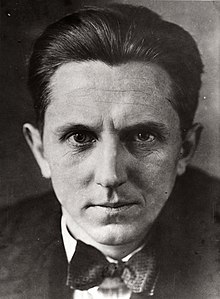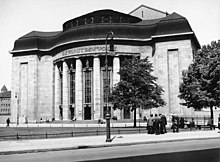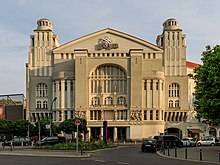Erwin Piscator
Erwin Piscator | |
|---|---|
 Portrait of Piscator, c. 1929 | |
| Born | Erwin Friedrich Max Piscator 17 December 1893 |
| Died | 30 March 1966 (aged 72) |
| Education | |
| Occupation(s) | Theatre director, producer |
| Known for | Founded the Maria Ley (m. 1937) |
| Relatives | Johannes Piscator |
| Signature | |
 | |
Erwin Friedrich Maximilian Piscator (17 December 1893 – 30 March 1966) was a German
Biography
Youth and wartime experience

Erwin Friedrich Max Piscator was born on 17 December 1893 in the small
Piscator began his acting career in the autumn of 1914, in small unpaid roles at the
During the
Early success in the Weimar Republic
Piscator returned to Berlin and joined the newly formed

In collaboration with writer
His dramatic aims were utilitarian — to influence voters or clarify left-wing policies. He used mechanized sets, lectures, movies, and mechanical devices that appealed to his audiences. In 1926, his updated production of
Piscator founded the influential (though short-lived) Piscator-Bühne in Berlin in 1927. In 1928 he produced a notable adaptation of the unfinished, episodic
In 1929 Piscator published his The Political Theatre, discussions of the theory of theatre .[12] In the preface to its 1963 edition, Piscator wrote that the book was "assembled in hectic sessions during rehearsals for The Merchant of Berlin" by Walter Mehring, which had opened on 6 September 1929 at the second Piscator-Bühne.[13] It was intended to provide "a definitive explanation and elucidation of the basic facts of epic, i.e. political theatre", which at that time "was still meeting with widespread rejection and misapprehension."[13]
Three decades later, Piscator said that:
The justification for epic techniques is no longer disputed by anyone, but there is considerable confusion about what should be expressed by these means. The functional character of these epic techniques, in other words their inseparability from a specific content (the specific content, the specific message determines the means and not vice versa!) has by now become largely obscured. So we are still standing at the starting blocks. The race is not yet on ...[14]
International work, emigration, and late productions in West Germany

In 1931, after the collapse of the third Piscator-Bühne, Piscator went to
In July 1936, Piscator left the Soviet Union for
During his years in Berlin, Piscator had collaborated with Lena Goldschmidt on a stage adaptation of Theodore Dreiser's bestselling novel An American Tragedy; under the title The Case of Clyde Griffiths. With American Lee Strasberg as director, it had run for 19 performances on Broadway in 1936. When Piscator and Ley subsequently immigrated to the United States in 1939, Piscator was invited by Alvin Johnson, the founding president of The New School, to establish a theatre workshop. Among Piscator's students at this Dramatic Workshop in New York were Bea Arthur, Harry Belafonte, Marlon Brando, Tony Curtis, Ben Gazzara, Judith Malina, Walter Matthau, Rod Steiger, Elaine Stritch, Eli Wallach, Jack Creley, and Tennessee Williams.[18]
Established in New York, Erwin and Maria Ley-Piscator lived at 17 East 76th Street, an Upper East Side townhome, sometimes remembered as the Piscator House.[19]
After World War II and the break-up of Germany, Piscator returned to West Germany in 1951 due to McCarthy era political pressure in the United States against former communists in the arts.[20] In 1962 Piscator was appointed manager and director of the Freie Volksbühne in West Berlin. To much international critical acclaim, in February 1963 Piscator premièred Rolf Hochhuth's The Deputy, a play "about Pope Pius XII and the allegedly neglected rescue of Italian Jews from Nazi gas chambers."[21] Until his death in 1966, Piscator was a major exponent of contemporary and documentary theatre. Piscator's wife, Maria Ley, died in New York City in 1999.
Effects on theatre
This section needs additional citations for verification. (December 2017) |

| In lieu of private themes we had generalisation, in lieu of what was special the typical, in lieu of accident causality. Decorativeness gave way to constructedness, Reason was put on a par with Emotion, while sensuality was replaced by didacticism and fantasy by documentary reality. |
| Erwin Piscator, 1929.[22] |
Piscator's contribution to theatre has been described by theatre historian Günther Rühle as "the boldest advance made by the German stage" during the 20th century.[23] Piscator's theatre techniques of the 1920s — such as the extensive use of still and cinematic projections from 1925 on, as well as complex scaffold stages — had an extensive influence on European and American production methods. His dramaturgy of contrasts led to sharp political satirical effects and anticipated the commentary techniques of epic theatre.[citation needed]
In the Federal Republic of Germany, Piscator's interventionist theatre model enjoyed a late second zenith. From 1962 on, Piscator produced several works that dealt with trying to come to terms with the Germans' Nazi past and other timely issues; he inspired mnemonic and documentary theatre in those years until his death. Piscator's stage adaptation of Leo Tolstoy's novel War and Peace[24] has been produced in some 16 countries since 1955, including three productions in New York City.[citation needed]
Legacy and honors

In 1980, a
Piscator's artistic papers are held by the archive of the Academy of Arts, Berlin (since 1966) and the Southern Illinois University Carbondale (Morris Library, since 1971).[27]
Broadway productions
- Gotthold Ephraim Lessing, Nathan the Wise (Belasco Theatre, April 1942)
- Irving Kaye Davis, The Last Stop (Ethel Barrymore Theatre, September 1944)
Films
- Revolt of the Fishermen (Восстание рыбаков). Director: Erwin Piscator, Screenplay: Georgi Grebner, Willy Döll, Producer: Mikhail Doller, USSR 1932–1934.
Works
- Piscator, Erwin. 1929. The Political Theatre. A History 1914–1929. Translated by Hugh Rorrison. New York: Avon, 1978. ISBN 978-0-413335-00-5).
- The ReGroup Theatre Company (ed.): The "Lost" Group Theatre Plays. Volume 3. The House of Connelly, Johnny Johnson, & Case of Clyde Griffiths. By Paul Green and Erwin Piscator. Prefaces by Judith Malina & William Ivey Long. New York, NY: CreateSpace, 2013. ISBN 978-1-484150-13-9.
- Tolstoy, Leo. War and Peace. Adapted for the Stage by Alfred Neumann, Erwin Piscator, and Guntram Prüfer. English adaptation by Robert David MacDonald. Preface by Bamber Gascoigne. London: Macgibbon & Kee, 1963.
Literature
- Connelly, Stacey Jones. Forgotten Debts: Erwin Piscator and the Epic Theatre. Bloomington: Indiana University 1991.
- Innes, Christopher D. Erwin Piscator's Political Theatre: The Development of Modern German Drama. Cambridge: Cambridge University Press 1972.
- Ley-Piscator, Maria. The Piscator Experiment. The Political Theatre. New York: James H. Heineman 1967. ISBN 0-8093-0458-9.
- Malina, Judith. The Piscator Notebook. London: Routledge Chapman & Hall 2012. ISBN 0-415-60073-1.
- McAlpine, Sheila. Visual Aids in the Productions of the First Piscator-Bühne, 1927–28. Frankfurt, Bern, New York etc.: Lang 1990.
- Probst, Gerhard F. Erwin Piscator and the American Theatre. New York, San Francisco, Bern etc. 1991.
- Rorrison, Hugh. Erwin Piscator: Politics on the Stage in the Weimar Republic. Cambridge, Alexandria VA 1987.
- Wannemacher, Klaus. "Moving Theatre Back to the Spotlight: Erwin Piscator’s Later Stage Work". In: The Great European Stage Directors. Vol. 2. Meyerhold, Piscator, Brecht. Ed. by David Barnett. London etc.: Bloomsbury (Methuen Drama) 2018, pp. 91–129. ISBN 1-474-25411-X.
- ISBN 0-413-37810-1.
External links
- Erwin Piscator at IMDb
- Website on Erwin Piscator, including "Annotated Erwin Piscator Bibliography" with more than 1300 title entries (German)
- Erwin Piscator Papers, 1930–1971 Archived 25 November 2020 at the Wayback Machine at Southern Illinois University Carbondale, Special Collections Research Center
- Information on the annual Erwin Piscator Award
- Photo of Piscator at Find a Grave
References
- ^ erwin-piscator.de (in German)
- ISBN 0-7172-5300-7
- ^ Willett, John. 1978. The Theatre of Erwin Piscator: Half a Century of Politics in the Theatre. London: Methuen. pg 13.
- ^ Willett (1978, 42).
- ^ Willett (1978, 43)
- ^ a b Willett (1978, 43).
- ISBN 978-1-4081-4924-9.
- ^ Willett (1978, 15–16, 46–47).
- ^ Willett (1978, 90–95).
- ^ See Brecht's Journal entry for 24 June 1943. Brecht claimed in his Journal entry to have written the adaptation, but Piscator contested that; the manuscript bears the names "Brecht, Gasbarra, Piscator, G. Grosz" in Brecht's handwriting (John Willett. 1978. Art and Politics in the Weimar Period: The New Sobriety 1917–1933. New York: Da Capo Press, 1996, 110). Brecht wrote another Schweik drama in 1943, Schweik in the Second World War.
- ^ The Kurt Weill Foundation for Music's Documentation on Muschel von Margate
- ^ Piscator (1929).
- ^ a b Piscator (1929, vi).
- ^ Piscator (1929, vii).
- ISBN 0-8204-1591-X
- ^ John Willett: Introduction, in: Erwin Piscator. 1893–1966. An Exhibition by the Archiv der Akademie der Künste Berlin, in cooperation with the Goethe Institute. Ed. by Walter Huder. London 1979, p. 1–4, p.1.
- ^ Hermann Haarmann: "Politisches Theater im Geiste der Polis. Die späte Heimkehr des Erwin Piscator". In: Freie Volksbühne Berlin 1890–1990. Beiträge zur Geschichte der Volksbühnenbewegung in Berlin. Ed. by Dietger Pforte. Berlin: Argon 1990. Pp. 195–210, p. 195.
- ^ Willett (1978, 166).
- ^ Art, Sebastian Izzard Asian. "MARCH 2004 and APRIL 2004". Sebastian Izzard Asian Art. Retrieved 16 March 2022.
- ^ Alexander Stephan: Im Visier des FBI. Deutsche Exilschriftsteller in den Akten amerikanischer Geheimdienste. Stuttgart, Weimar 1995, p. 373.
- ISBN 0-8204-1591-X
- ^ From a speech given on 25 March 1929, and reproduced in Schriften 2 p.50; Quoted by Willett (1978, 107).
- ^ Günther Rühle: "Erwin Piscator: Dream and Achievement", in: Erwin Piscator. 1893–1966. An Exhibition by the Archiv der Akademie der Künste Berlin, in cooperation with the Goethe Institute. Ed. by Walter Huder. London 1979, p. 12–19, p. 16.
- ^ Leo Tolstoy. War and Peace. Adapted for the stage by Alfred Neumann, Erwin Piscator and Guntram Prüfer. London: Macgibbon & Kee 1963.
- ^ Piscator – The Making of Eduardo Paolozzi's Euston Square Sculpture. Director: Murray Grigor. Inverkeithing: Everallin 1984 (documentary film).
- ^ Erwin Piscator Monument (in German), Greifenstein-Ulm website
- ^ Archive Performing Art at Academy of Arts, Berlin (in German), website, Erwin Piscator Papers, Southern Illinois University Carbondale, website Archived 25 November 2020 at the Wayback Machine
